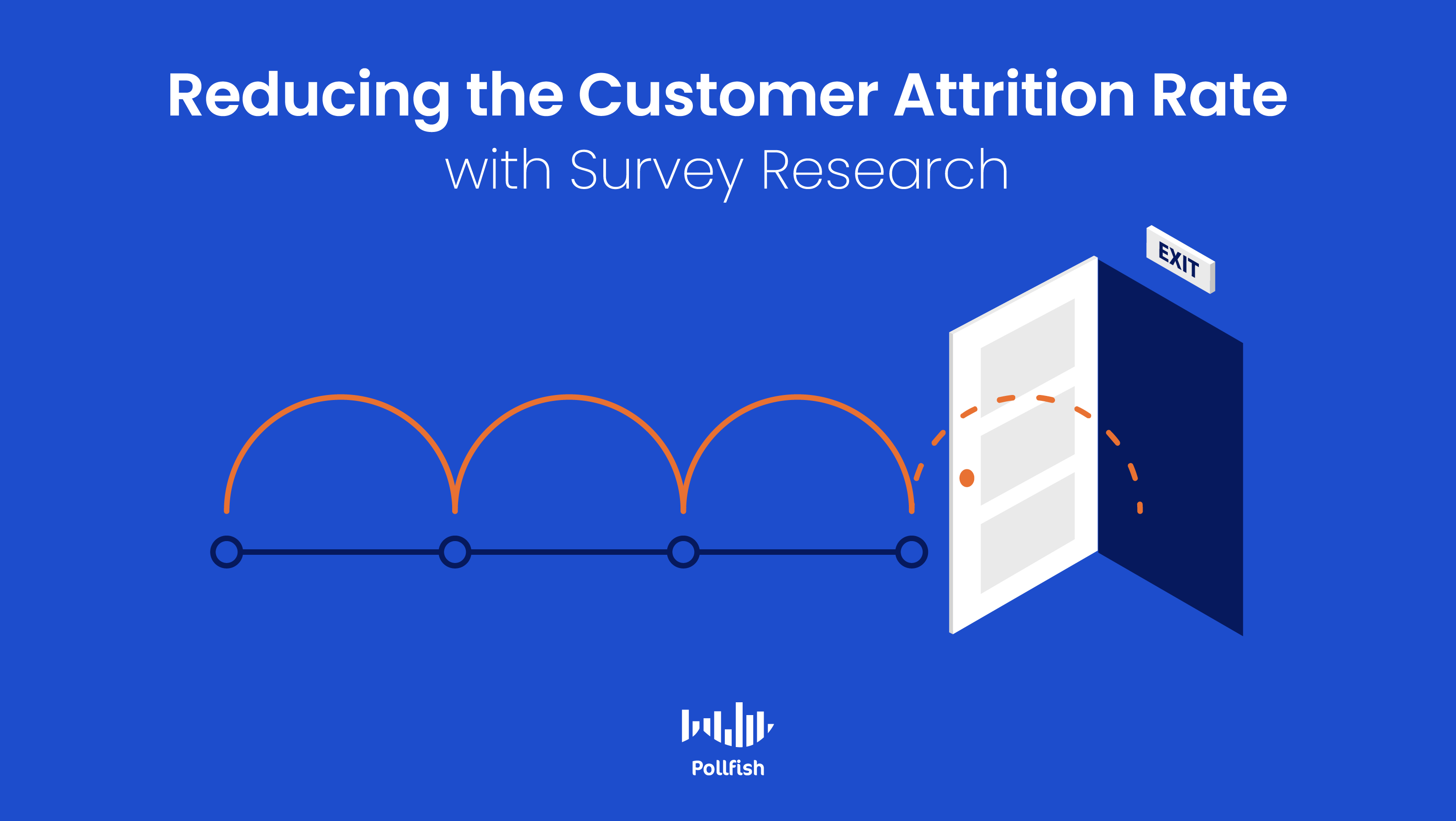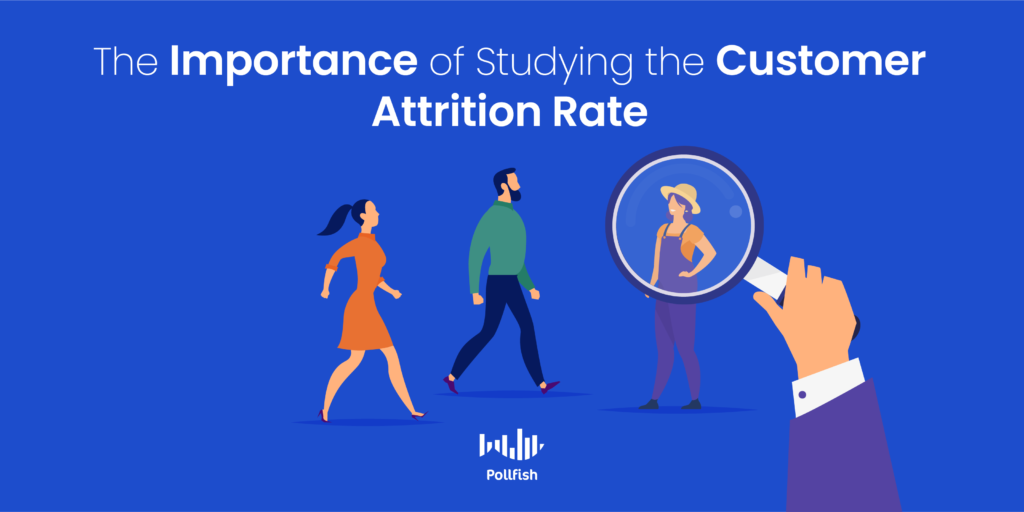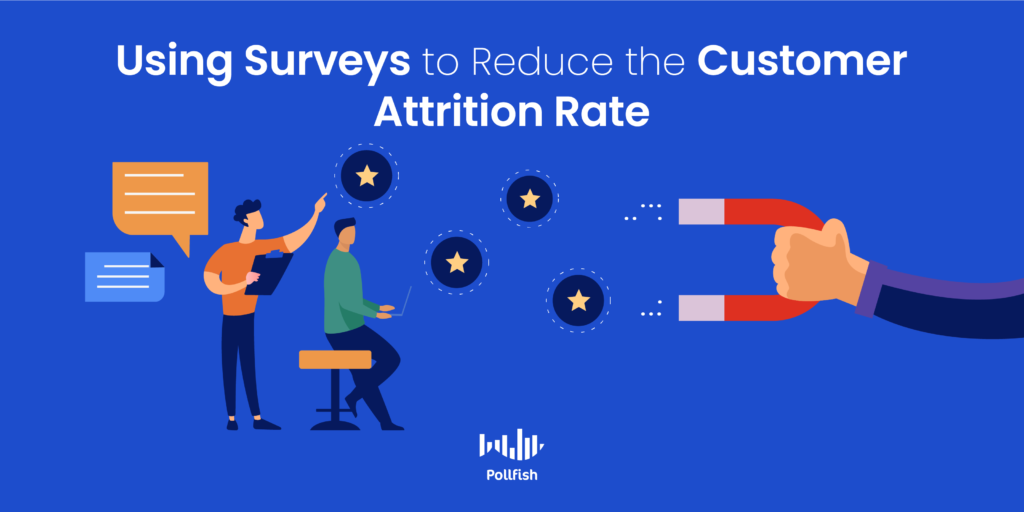Cutting the Customer Attrition Rate with Surveys

Brands must monitor their customer attrition rate regularly, as customer attrition occurs in all businesses. Gauging the rate at which customers churn, this measurement is crucial to keep track of, as it directly affects subscriptions, sales, revenue and a company’s general stance in regards to its customers.
23-30% of all American companies lose their customers annually, due to a lack of consumer loyalty. This rate alone is severe, yet it only measures customer attrition that springs from a lack of consumer loyalty, pointing to many other existing reasons that cause customers to churn.
Another cause behind customer attrition is customer service, as 71% of consumers end their relationship with a business due to poor customer service. While the loss of a customer will vary from business to business in terms of value, the average value of a lost customer globally is $243.
These figures present the serious consequences and implications of customer attrition. Businesses can nip it in the bud or at the very least, stay aware of it by studying its metric.
This article explains the customer attrition rate, the importance of studying it, its two main types, how to calculate it, how surveys help reduce it and more.
Understanding the Customer Attrition Rate
Interchangeably called the customer churn rate and customer turnover rate, this rate refers to the percentage of customers lost within a given time period, which can be weekly, monthly or annually. Although this metric is typically defined by customers, it can also be defined by products.
Although this rate is used interchangeably with the customer churn rate, it should not be confused with it, as the customer churn rate focuses solely on lost customers, whereas the customer attrition rate considers both how many customers were lost and how many were gained during a specific period.
This rate is the antithesis of the customer retention rate, which measures the number or percentage of customers that a business retains over a given period of time. Ideally, the attrition rate ought to be kept as low as possible in order to sustain higher retention rates and keep a business profitable.
Consideration of the attrition rate is especially important for businesses with recurring revenue models, such as SaaS companies and subscription-based businesses. In these businesses, the customer attrition rate refers to the number or percentage of service subscribers that discontinue their subscriptions in a given time period.
However, all companies ought to monitor this rate, as all companies lose customers, even some of the most loyal. In addition, there are also customers who make one-time purchases. All in all, customer retention is not guaranteed and a customer relationship with a business is rarely, if ever, permanent.
The Importance of Studying the Customer Attrition Rate

This rate is crucial to track periodically and most importantly, to keep it at a minimum. There are various factors that make up the importance of studying this metric and keeping it low.
First off, it is crucial to track this rate, as every lost customer requires acquiring a new one. While important as well, customer acquisition is more expensive and not as convenient as customer retention, as it costs 5 times more to acquire a new customer than it does to retain an existing one. Existing customers are also far more valuable, as customers will pay up to 57% more on brands they are loyal to.
Although acquisition costs are required in sales, marketing, advertising and customer onboarding efforts, retention is still more profitable, as merely a 5% increase in retention rates can reap 25-95% in extra profit.
Customer acquisition can be difficult, but winning back a lost customer is even more difficult, as the damage has already been done and they’ve made up their minds. The loss of customers is also obviously harmful to revenue and can therefore reduce profits significantly.
Next, this metric is necessary to check, as it is a key performance indicator (KPI) that businesses need to stay aware of to ensure that they are making the correct decisions in their strategic planning process and beyond. To this end, this rate also affects a business’s ROI.
It is possible for some customer acquisition expenditures to represent a negative ROI for a company, which represents a loss of money for the company. This occurs when a business substantially invests in its customer acquisition efforts, yet new customers don’t stick around for long enough.
Another reason behind the importance of performing a customer attrition analysis is that if a customer attrition rate is too high, it may be due to a fundamental problem with a company’s offering. It may also signify problems in other areas, such as customer experience, the products and services, the prices and more.
Additionally, it is critical to measure this rate, as a high customer attrition rate often carries a far-reaching impact, which can manifest in reputational damage.
When more and more customers become unhappy and leave a business for good, a significant chunk of them will make their unhappiness known and spread it to the public — whether through social media, review sites, forums, comments on blogs and other digital properties or simply poor assessments via word-of-mouth.
The Two Kinds of Customer Attrition
There are two forms of customer attrition; it is vital for marketers and market researchers to differentiate the two of them. The two forms are active customer attrition and passive customer attrition.
Active Attrition
This kind of attrition is typically associated with subscription business models. These include businesses in the SaaS, telecom, publishing and Internet industries. Active attrition occurs when a customer cancels their subscription to a SaaS product, a phone line, a magazine, a newspaper, an app, a streaming service, etc.
A business’s retention experts who are tasked with lowering active attrition have an advantage: they know precisely when a customer is going to leave. This allows them to carry out marketing tactics bent on changing the customer’s mind. These include lowering subscription costs, offering free add-ons and more.
The disadvantage lies in having to change the minds of consumers who have decided to churn, as there is no guarantee that even the most aggressive marketing techniques will bring back this patronage.
Passive Attrition
Passive attrition refers to the phenomenon of a customer who simply stops buying from or engaging with a business. This kind of attrition is predominantly associated with e-commerce websites, retail stores, on-request service providers and other kinds of non-subscription-based businesses.
There is a major challenge in reducing passive attrition, as it relies on predicting when a customer is about to leave. At times, marketers and market researchers will be able to pinpoint “churn signals” before a customer leaves. In this instance, they can perform marketing techniques to prevent customers from churning.
This involves providing customers with relevant offers and otherwise enticing them to remain active customers. There are also times in which businesses can regain lost customers. However, it is typically more feasible to retain customers with a risk of leaving than it is to regain customers who have churned.
How to Calculate the Customer Attrition Rate
Calculating the customer attrition rate is a simple process for many businesses, especially subscription-based businesses and agencies, as they hold lists of active clients. These kinds of businesses can easily refer to their active client lists when working out this rate.
But for businesses in other verticals such as retail stores, this is likely to be a more difficult and less accurate process. This is because for these businesses, determining the exact number of active customers is rather subjective.
There are two ways to calculate this rate. As such, there are two formulas making up this metric. Before plugging the variables into the formulas, businesses should first narrow down how they intend to measure attrition. This can include:
- Measuring the number of lost clients
- Expressing customer attrition as a percentage
- Discovering the loss in recurring business value
- Calculating the percentage of loss in recurring value
Customer Attrition Rate Formula
The basic gross customer turnover rate formula is simple and can apply to the first two points above. The formula is as follows:
The number of churned customers by the end of a period divided by the total number of customers at the beginning of that period.
For example, a company that had 700 customers at the beginning of the month and 600 customers at the end of the month would use the following attrition rate formula:
Number of customers lost: 700 – 600 = 100 customers
Number of customers at the beginning of the period: 700
Attrition rate formula: 100/700 = 0.1428 or 14.28%
The second customer attrition rate formula involves new customers that a business has gained by the end of the same period.
For example, a company that had 800 customers at the beginning of the month, lost 120 customers by the end of the month and also gained 70 new customers by the end of that period would use the following attrition rate formula:
Number of customers lost: 120 customers
Number of customers at the beginning of the period: 800
Number of new customers by the end of the period: 70
Attrition rate formula: 120 / (800+ 70) = 0.1379 or 13.79%
Good Vs Bad Customer Attrition Rates
A common question to consider is what constitutes a good and a bad customer turnover rate? There is no definitive answer to this question. Ideally, brands should keep their customer attrition to a minimum, which means keeping lower rates.
In this regard, a rate at over 50% is evidently too high; they signify that at least half of your customers are churning. However, if your business falls under ecommerce, on-demand services or retail, this may be a typical rate of passive attrition, as plenty of customers make one-off or infrequent purchases.
If, on the other hand, your business is SaaS or uses some other sort of subscription-based model, this rate is objectively bad, as it shows customers are breaking their subscriptions. When customers don’t stay within their expected subscription time, a business loses streams of expected revenue.
This rate can also point to customers who don’t renew their subscriptions, which can be an indicator of poor UX, products or losing out to competitors. As such, a 50% attrition rate is especially harmful as active attrition.
Businesses should aim for low rates of customer attrition, which although aren’t definitive, typically exist in rates of 25% and under. This indicates that about a quarter and under of your customers churn. This is especially a low rate for non-subscription businesses.
For SaaS and other subscription-based companies, 25% is still a high attrition rate, given that retention is much more valued in these businesses, given that they thrive on the longevity of their customer relationships, which exist in the form of subscriptions.
Successful SaaS companies typically see a customer attrition rate in the single digits. As such, in this industry, a good turnover rate is under 10%.
The Customer Attrition Rate Across Industries
This rate varies by industry and business. While it is not possible to tally this metric across every business in a niche, it is practical to gain a high-level view of it across industries.
The following lists the customer attrition rates across industries:
- Cable: 25%
- Retail: 24%
- Online retail: 22%
- Financial services: 25%
- Telecom: 21%
- Travel: 18%
- Electronics: 11%
- SaaS: 6%
How Surveys Help Reduce the Customer Attrition Rate

Survey research can go a long way towards reducing the customer attrition rate, as it brings businesses a wealth of customer intelligence. First off, surveys can identify dissatisfied or unhappy customers, along with those who seek better CX, more reasonably-priced products and much more.
As such, surveys provide businesses with a means of catching unhappy customers before they churn. The insights that businesses gain from these surveys allow them to take the appropriate actions to reverse customer dissatisfaction and fulfill their needs, desires and the like.
Surveys allow market researchers to deeply examine virtually any issue they choose. This makes it possible to understand customers at a granular level, as researchers can question them on specific topics.
Survey research also equips businesses with both quantitative and qualitative market research, providing a holistic market research approach for examining customers.
In terms of quantitative research, researchers can deploy thousands of surveys in just one round (depending on the online survey platform they use), granting them a means of statistical significance for quantitative data. They would need to set up multiple-choice questions to gain quantitative data.
As for reaping qualitative data, market researchers can create surveys with open-ended questions, allowing respondents to express their ideas, opinions, unique needs, aversions and more. This grants businesses a deeper understanding of their customers, allowing them to strategize accordingly to ward off customer churn.
As such, businesses can use surveys to fully understand their customers, cater to them aptly, reverse any negative feelings towards their company and much more. Essentially, surveys are customer intelligence powerhouses that make it quick and convenient to study customers, along with trends in an industry.
Keeping Churn at Bay
While customer attrition is inevitable, businesses can still keep a pulse on their customers to retain them, minimizing their customer turnover in the process. Surveys are the key tools for achieving this, as they allow businesses to probe deeply into the minds and habits of their target market.
With this in mind, businesses need to use a strong online survey platform to carry out successful survey campaigns. Such a platform should make it easy to hyper-target respondents, create and deploy surveys, extract the highest quality of data via artificial intelligence and machine learning, set quotas to fine-tune the respondent pool and use an intended sampling pool size and more.
A business that uses such an online survey platform is well-equipped to study its customers, along with their needs and dissatisfactions. This will enable them to make informed decisions that thwart their customers’ unhappiness and retain more of them. Thus, this kind of survey software has a direct effect on reducing the customer attrition rate.
Do you want to distribute your survey? Pollfish offers you access to millions of targeted consumers to get survey responses from $0.95 per complete. Launch your survey today.
